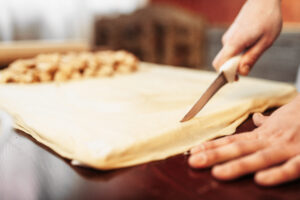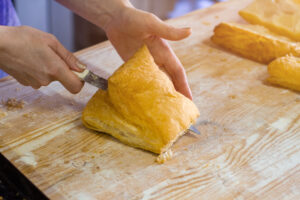Puff pastry is a culinary delight that can elevate any dish, from savory appetizers to sweet desserts. However, achieving that perfect, flaky texture requires knowledge and technique. Understanding what to avoid when working with puff pastry is just as important as knowing how to use it. This article will explore common mistakes, preparation and baking tips, and advanced advice to help you perfect your puff pastry creations.
Common Mistakes to Avoid
Rushing the Thawing Process
In the realm of baking, particularly when working with puff pastry, understanding and respecting the thawing process is paramount. This section delves into why rushing the thawing phase is a common mistake and how to avoid it to ensure your pastry turns out perfectly every time.
The Virtue of Patience in Thawing
Puff pastry thrives on patience, especially during thawing. Here’s why hurrying this crucial step can negatively impact your culinary creations:
- Irregular Baking: A hastily thawed pastry is prone to bake unevenly, leading to parts that are too brown or undercooked.
- Compromised Texture: The essence of puff pastry lies in its layers. Rushing thawing can melt the butter unevenly, leading to a dense rather than flaky texture.
Gradual Thawing: The Recommended Approach
To preserve the integrity and structure of your puff pastry, a gradual thaw in the refrigerator is advised. Here are the steps and tips to ensure optimal thawing:
- Plan Ahead: Allocate sufficient time for thawing, ideally allowing the pastry to rest in the refrigerator overnight.
- Consistent Refrigeration: Ensure the pastry remains in a consistent, cold environment to facilitate an even thaw.
Tips for Thawing Success
- Avoid Room Temperature: Thawing at room temperature might seem quicker but can result in uneven texture and spoilage.
- Monitor the Process: Regularly check on the pastry’s progress to ensure it thaws evenly, adjusting its position in the fridge if necessary.
Additional Considerations
- Brand-Specific Instructions: Be mindful of any specific thawing guidelines provided by the puff pastry brand.
- Handling Post-Thaw: Work with the pastry promptly after thawing to prevent it from becoming too warm, which can affect the layers.
Patience is not just a virtue but a necessity when thawing puff pastry. By allowing the pastry to thaw gradually in the refrigerator, you ensure a superior texture and even baking. This meticulous approach sets the stage for exquisite pastries that are as delightful to the eye as they are to the palate.
For a deeper understanding of proper thawing techniques and to master the art of working with puff pastry, be sure to explore further.
Adhering to these guidelines will not only elevate your baking skills but also enhance the quality of your puff pastry dishes, making each bite a testament to the care and patience invested in the preparation process.
Rolling the Dough Improperly
The act of rolling out puff pastry dough is an art that requires precision and a gentle touch. The balance between the amount of pressure applied and the technique used is critical. Applying too much pressure can compromise the dough’s delicate layers, leading to a loss of its characteristic flakiness. On the other hand, too little pressure might not spread the dough evenly, resulting in patches of uneven thickness that bake inconsistently.
The Right Way to Roll
To achieve the perfect thickness and maintain the integrity of the puff pastry, follow these expert tips:
- Start with the Right Tools: Use a rolling pin that allows you to apply even pressure across the width of the dough.
- Even Pressure is Key: Aim for a consistent pressure as you roll out the dough, ensuring an even thickness throughout.
- Rotate the Dough: This helps achieve a uniform shape and thickness. Gently turning the dough 90 degrees after a few rolls ensures an even expansion.
- Chill the Dough: If the dough becomes too warm and begins to stick, place it back in the refrigerator for a few minutes. Working with a cooler dough makes rolling easier and helps preserve the layers.
Common Mistakes to Avoid
When rolling puff pastry dough, several common pitfalls can affect the outcome:
- Overworking the Dough: This can lead to gluten development, making the pastry tough instead of light and flaky.
- Ignoring Dough Temperature: Warm dough is more likely to stick and tear. Keep the dough cool for the best results.
- Uneven Thickness: Inconsistent thickness can cause the pastry to bake unevenly. Aim for uniform thickness across the entire sheet.
Final Thoughts
The technique of rolling out puff pastry dough plays a pivotal role in the success of your baked goods. It’s a delicate balance that, when mastered, leads to beautifully layered and flaky pastries that are both visually appealing and delightfully textured. Remember, patience and attention to detail are your best tools in achieving pastry perfection.
For further guidance on rolling techniques and how to avoid common mistakes, explore here.
Incorporating these tips into your baking routine will enhance your puff pastry dishes, making them a surefire hit with any audience. Happy baking!
Using a Dull Knife for Cutting
When it comes to preparing puff pastry, the choice of cutting tool plays a pivotal role. A sharp knife is not just a recommendation; it’s a necessity for ensuring the integrity of your pastry. Here’s why:
- Precision Cutting: A sharp knife ensures clean and precise cuts. This precision is crucial for maintaining the delicate layers of the puff pastry that are instrumental in achieving its characteristic rise.
- Layer Preservation: Using a dull knife can lead to compressed layers. This compression hampers the pastry’s ability to rise evenly during baking, leading to a less flaky and appealing texture.
Avoiding Common Mistakes
To maximize the potential of your puff pastry, consider the following tips:
- Regularly sharpen your knives to maintain their efficiency. A well-maintained knife can make a significant difference in the outcome of your pastry.
- Opt for a straight-edge knife over a serrated one when cutting puff pastry. The clean cut of a straight-edge knife helps in preserving the layers better.
Enhancing Your Baking Success
In addition to using a sharp knife, there are other factors to consider for achieving the perfect puff pastry:
- Temperature Control: Ensure your pastry is cold before cutting. This firmness allows for cleaner cuts, further protecting the layers.
- Baking Immediately: Once cut, bake your pastry promptly. Delaying can cause the fat within the layers to warm up, affecting the pastry’s rise.
By adhering to these guidelines, you can significantly improve the quality of your puff pastry dishes. Remember, the goal is to preserve those precious layers that give puff pastry its delightful texture. A sharp knife is your best ally in this endeavor.
In conclusion, never underestimate the power of a sharp knife in the realm of baking, especially with puff pastry. It’s a simple tool, but its impact on your baking results is profound. Happy baking, and may your pastries always rise to the occasion!
Preparation and Baking Tips
Avoiding Overworking the Dough
Creating the perfect puff pastry is akin to conducting a symphony. Every element must harmonize, especially when it comes to handling the dough. The secret to a flaky, light, and airy pastry lies in understanding the delicate balance required during its preparation.
The Science of Dough Handling
At the heart of puff pastry‘s magic is the intricate layering of dough and butter. Here’s why gentle handling is paramount:
- Butter Melting: The primary risk of overworking the dough is the warmth from your hands melting the butter. This melting compromises the distinct layers necessary for the pastry to puff.
- Layer Integrity: Maintaining the integrity of these layers ensures that, upon baking, the steam produced by the melting butter inflates the dough. This process is what gives puff pastry its characteristic rise.
Tips for Perfect Dough
To avoid the common pitfall of overworking your dough, consider these tips:
- Use cold ingredients to minimize the risk of the butter melting prematurely.
- Limit the time your hands are in contact with the dough. Consider using tools like a dough scraper or rolling pin to minimize direct handling.
- Be mindful of the dough’s texture; it should feel pliable but not elastic. Elasticity indicates gluten development, which can lead to toughness.
Achieving the Perfect Puff
Here are additional strategies to ensure your puff pastry reaches its full potential:
- Chill Regularly: Between rollings, chill the dough to keep the butter firm.
- Roll Gently: Apply even, gentle pressure when rolling. This approach helps maintain layer distinction without compressing the dough too much.
- Monitor Temperature: Work in a cool environment to prevent the butter from softening too much.
By embracing these practices, you’re not just making pastry; you’re crafting an experience. The layers of a well-made puff pastry are not merely a testament to your skill but a celebration of texture and taste that only meticulous preparation can achieve.
In essence, the journey to mastering puff pastry is one of patience and precision. Remember, the beauty of puff pastry lies not just in its taste but in its texture. By avoiding the overworking of the dough, you ensure that each bite is as light as air and delightfully flaky.
Not Chilling the Dough Before Baking
The secret to achieving that coveted, flaky puff pastry texture lies significantly in temperature control. Specifically, the act of chilling the dough before it hits the oven is more than just a step; it’s a necessity.
- Preserving Butter Layers: Chilling solidifies the butter, ensuring that when the pastry bakes, these layers vaporize into steam, puffing up the dough. This process is what gifts puff pastry its signature flakiness.
- Enhancing Texture: By keeping the butter from melting into the dough prematurely, chilling helps maintain the distinct layers crucial for that perfect texture.
Implementing Effective Chilling
To incorporate this essential step effectively:
- Chill the dough for at least 30 minutes before baking. This duration allows the butter to harden sufficiently.
- Consider the environment. A cooler kitchen can contribute to keeping the dough at an optimal temperature.
Incorporating this chilling phase into your puff pastry preparation routine ensures the layers remain separate and distinct, setting the stage for the ultimate rise and texture. Remember, patience in preparation translates to perfection in every bite.
Ignoring Oven Temperature
A consistent and correct oven temperature is vital. Preheating the oven ensures that your puff pastry cooks evenly and rises perfectly.
Handling and Storing Puff Pastry
Improper Storage Methods
Ensuring the longevity and quality of puff pastry hinges on employing the right storage methods. Both refrigeration and freezing play pivotal roles, each with its set of best practices.
Refrigeration for Short-Term Storage
- Keep the puff pastry in its original packaging to minimize exposure to air.
- If opened, wrap tightly in plastic wrap to prevent drying out.
Freezing for Longevity
- Freeze puff pastry in airtight containers or freezer bags to protect against freezer burn.
- Label with the freezing date to track freshness.
By adhering to these storage principles, you can maintain the delicate balance of moisture and fat essential for puff pastry‘s texture and flavor. For a comprehensive guide on storing puff pastry effectively, click here. This resource offers invaluable insights into maximizing the shelf life of your pastry, ensuring it remains ready for your next culinary creation.
Using Puff Pastry Beyond Its Prime
It’s important to recognize the signs of puff pastry that has gone bad, such as a sour smell or discoloration, to avoid poor results in your baking.
Advanced Tips for Perfect Puff Pastry
Choosing the Right Fat Content
The debate between all-butter and mixed-fat puff pastries is significant, with all-butter varieties generally providing a richer taste and better rise.
Adjustments for Humid Climates
Humidity can adversely affect puff pastry, making it necessary to adjust your preparation methods, such as by altering the flour type or storage conditions.
FAQs
- Why is my puff pastry not puffing? Common reasons include overworking the dough and not chilling it properly before baking.
- Can I refreeze thawed puff pastry? It’s not recommended as it can affect the texture and rise.
- How long can I store puff pastry in the fridge? Typically, puff pastry can be stored in the fridge for up to 3 days.
- Is it necessary to use an egg wash on puff pastry? While not always necessary, an egg wash can enhance the golden color and crispiness.
- Can puff pastry be made with margarine instead of butter? Yes, but butter offers a richer flavor and better layers.
Conclusion
Remembering key points like the importance of patience during thawing, the technique in rolling, and the necessity of proper temperature control can make all the difference in puff pastry baking. Experimenting with these guidelines will help you achieve the best results and elevate your dishes with the flaky, golden perfection that is puff pastry. For a guide on how to master the art of working with puff pastry to create delicious breakfast recipes, be sure to explore further in The Ultimate Guide to Puff Pastry Breakfast Recipes.



